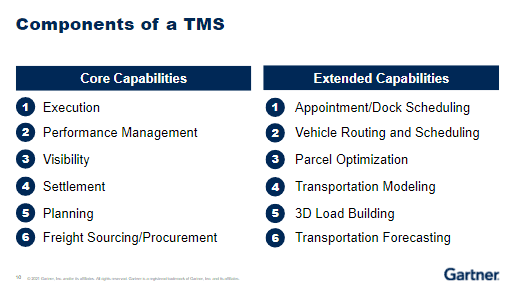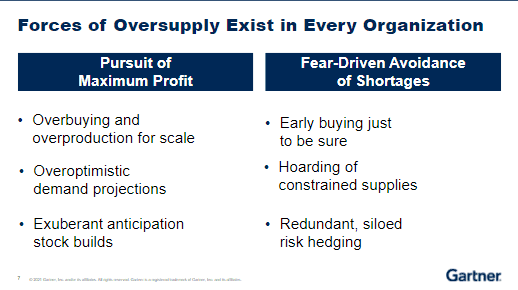Two weeks ago I wrote a "Couch Report" on the recent Gartner Supply Chain Supply Chain Symposium 2021
Since it was again an all-virtual event, I titled my summary as with other summaries of on-line events a Couch Report, rather than the usual Trip Report, since I attended from the comfort of my nice padded chain or sofa.
That first week, I focused on the opening keynote presentation by Gartner analysts Dana Stiffler and Simon Bailey. Last week, I called it "rather extraodinary," as it posited (greatly over simplifying) supply chain is both "cause and cure" for a wide swath of the world's "fractures."
Gilmore Says.... |
 |
| Lord said with unprecedented demand and supply volatility, various stakeholders often have unrealistic expectations about inventory performance. |
 |
What do you say? |
|
| Click here to send us your comments |
| |
|
|
|
To learn more, go to that week's column here.
Last week, I summarized two other keynote presentations, both by outsiders and oddly both presentations on innovation. You can find that here.
This week, I am back with review and comment on three solid breakout sessions from the Gartner conference.
I will start with a session on Warehouse Management Sytems (WMS), led as part of the “Magic Quadrant” series of presentations by my friend and well-known analyst Dwight Klappich. The Magic Quadrant (MQ) of course is Gartner’s framework for evaluating vendors across a wide variety of technology and service areas.
Klappich detailed what he sees as key trends in WMS technology. As an intro to those trends, Klappich first noted that Warehouse Management Systems are getting smarter.
“We see vendors adding a lot of intelligence with more sophisticated tools for planning labor, planning work, forecasting capabilities,” Klappich said.
The first WMS trend cited by Klappich is what he calls "distribution center resource planning and optimization," which has been around for a while but is now getting more advanced and starting to deliver real results.
The promise of these capabilities is to get tasks done in the warehouse more efficiently by considering constraints in planning the work, Klappich said, adding that machine learning is starting to play a role here a well.
Klappich’s second trend involves what he calls “radical changes” in WMS technical architectures to what is called a "micro-services based platform." The promise is to be able to assemble these mini-services to easily develop desired business processes, and to enable the WMS to easily make calls to get data from external systems such as a TMS.
Klappich said in fact he believes a WMS’ technical architecture is rising in importance in the vendor selection process.
Finally, and not surprisingly, Klappich cites the need for improved integration with materials handling systems, especially mobile robots, as a third key WMS trend.
There is huge interest in various forms of warehouse automation, Klappich noted, driven by rising labor challenges in both cost and availability – and WMS needs to step up to the challenge.
With that I will transition to another Magic Quadrant-based session, this one on Transportation Management Systems (TMS). It was led by Garter’s Brock Johns, who must have taken TMS coverage over from Bart De Muynck, who delivered the TMS presentation in 2020, and is still at Gartner.
It’s generally good times for TMS vendors, with many companies turning to technology to deal with all the highly publicized transportation woes in 2021. Johns says the TMS market continues grow faster than the overall supply chain software revenues, and is up an estimated 60% in the past 5 years.
That growth is catching the attention of many, and has led to a slew of mergers and acquisitions, as well as big dollars from investors. And many TMS vendors that weren’t that interested in partnerships to expand their reach a few years ago are now singing a new partnership tune, Johns said.
An example of the acquisition activity is the fairly recent move by Uber Freight to buy 3PL/TMS provider Transplace. On the partnership side, a number of TMS companies have developed integrations with various digital freight platforms.
With that backdrop, Johns sees a number of key trends:
The nearly complete move to TMS in the Cloud, with TMS being one of the earliest supply chain software categories to head in the Cloud direction.
A focus from TMS vendors on improved usability and user experience.
Lower total cost of ownership for TMS solutions, driven in part by faster implementations coming from Cloud deployment and resulting in more rapid time-to-value.
Complementary “ecosystems” – it’s not just the TMS, but the array of partners that address related areas that uow drive many buying decisions, as I discussed above, especially for larger TMS buyers with complex needs.
An “all miles” focus – TMS was traditionally focused on so-called first and middle miles, but naturally enough many are adding last mile capabilities to support ecommerce (parcel management and routing, for example).
Johns’ presentation included this basic but nevertheless potentially useful chart showing “core” and “extended” TMS capabilities.

I saved an interesting if a little deep presentation on the “Five Priorities for the Head of Supply Chain Planning who wants Inventory Excellence, ” delivered by Gartner’s Paul Lord, for last, for the practical reason that I knew it would be by far the hardest to summarize.
Indeed, I think Lord may have the best supply chain analyst job at Gartner, focusing in recent years on inventory management, supply chain costs, and other such topics, not a given technology area(s).
This presentation was certainly similar to one he gave at the 2020 event. At times, Lord borders on getting a bit academic in tone, but usually pulls it back from the brink and delivers solid material – though it required putting your thinking cap on.
Where to begin. Lord said with unprecedented demand and supply volatility, various stakeholders often have unrealistic expectations about inventory performance, especially as many companies lack needed tools.
“What looks like excess inventory is really just a symptom of the disconnect between the capability of the network and the performance expectations of shareholders,” Lord said.
That’s exacerbated by the fact there are many forces that tend to push for more inventory. As shown in the chart below, Lord divides those forces into two types: (1) those associated with maximizing profits (e.g., over buying or producing, hoping to benefit from economies of scale); and (2) those associated with fear of shortages/out-of-stocks, such as multiple parts of the supply chain all holding excess inventory of the same SKUs.

There is a ton more, but for space reasons I am going to have to go straight to the five priorities. They are:
1. Move beyond just “operating for cash” by reducing inventory levels to a more holistic view that embraces, for example, supply network improvements and digital innovation, and shifts the conversation from “inventory levels” to key strategic questions and profitable growth.
2. Engage stakeholders on what Lord calls the three decision layers for inventory: At the bottom are decisions around classic supply chain trade-offs, such as inventory vs service. Next up: situational decisions, which have to do with unique scenarios, such as a new product introduction or sudden market opportunity. At the top, strategic design choices, including such areas as resilience and inventory levels "baked in" by network design.
3. Invest in supply network modeling tools and analytics: combining demand, supply, constraints, variability and more in one digital model.
4. Emphasize performance over strategies and models: Big topic, but Lord showed an analytic tool that plots basically different levels of inventory spend (e.g., fast movers) against the level of demand volatility. The result enables SKU segmentation and tailored inventory strategies.
5. Optimize effort and risk with careful alignment and sequencing of proposed actions: Lord showed how an offshoot of the tool shown in #4 can be used to communicate on inventory strategies and sequencing to gain consensus across stakeholders.
Whew. A lot to ponder
I am out of space. May or may not due one more summary of breakout sessions next week.
What's your take on any of these breakout session summaries? Let us know your thoughts at the Feedback button or section below.
Your Comments/Feedback
|